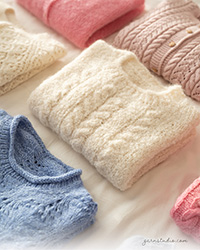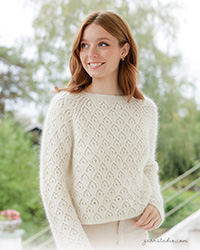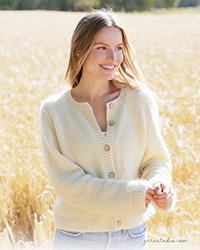Comments / Questions (17)
![]() Lyne Côté wrote:
Lyne Côté wrote:
Puis je avoir le modèle de moufle
03.11.2025 - 18:17DROPS Design answered:
Bonjour Mme Côté, vous trouverez les explications des moufles ici. Bon tricot!
04.11.2025 - 08:24
![]() Lyne Cote wrote:
Lyne Cote wrote:
J’aimerais avoir ce patron de moufle
03.11.2025 - 18:13
![]() Joanna wrote:
Joanna wrote:
Dzień dobry, mam pytanie o wzór: na wzorze jest pokazany co drugi rząd? Jeżeli robię cała czapkę na drutach pończoszniczych to co drugi rząd robię tak jak oczka schodzą z drutów?
26.11.2021 - 09:55DROPS Design answered:
Witaj Joanno, wzór/schemat pokazuje wszystkie rzędy, widok na prawej stronie robótki. Jak odczytywać schematy w robótce na drutach znajdziesz TUTAJ. Patrz część, gdzie jest opisana robótka wykonywana na okrągło. Miłej pracy!
26.11.2021 - 10:53
![]() Emma wrote:
Emma wrote:
Ni har skrivit fel på mönstret i "stjälkarna" till bubblorna/bären. På M2, varv 2 maska 6-7 ska man sätta en m bakom arbetet, 1rm, 1am från hj.st. och samma med varv 2 maska 9-10 ska man sätta en m framför arbetet, 1am, 1rm från hj.st. Ni har råkat skriva tvärtom på hela M2 diagrammet. Märkte det när jag hade stickat nästan hela M2 att det var fel. Även på vantarna är det fel.
08.11.2021 - 15:55
![]() Sue wrote:
Sue wrote:
Hello, can you tell me where to find the mitten pattern for the 123/14 berry set as there would appear to be only instructions for the hat and cowl?
20.09.2020 - 11:37DROPS Design answered:
Hello Sue, here you can find pattern for mittens . Happy knitting!
20.09.2020 - 14:34
![]() Levert wrote:
Levert wrote:
Bonsoir le bonnet est magnifique je souhaite le tricoter avec des aiguilles n8 combien dois je faire de maille? Et du coup est ce que se sera la même explication vu qu'il y aura moins de mailles? Merci
04.01.2019 - 21:39DROPS Design answered:
Bonjour Mme Levert, le bonnet se tricote ici sur la base d'un échantillon de 18 m x 23 rangs = 10 x 10 cm, si vous n'avez pas cet échantillon, il faudra ajuster les explications en fonction de votre propre échantillon. Nous ne sommes malheureusement pas en mesure de pouvoir ajuster chaque modèle à chaque demande. Pour toute assistance complémentaire, merci de vous adresser au magasin où vous avez acheté votre laine. Bon tricot!
07.01.2019 - 09:23
![]() Kathy Kilmaer wrote:
Kathy Kilmaer wrote:
My head circumference measures 22 1/2 inches. If I did one extra repeat of M-1, would that help. I love the pattern, however, I am not an experienced knitter, so I am not sure how to adjust the pattern to fit me. Thank you.
14.12.2018 - 16:07
![]() Luciana Luciani wrote:
Luciana Luciani wrote:
Ho iniziato il berretto. Dopo i primi 3 cm ho aumentato 5 maglie per un totale di 101 maglie. Il primo ferro dello schema M1 termina con una maglia singola in avanzo. E' giusto così?
13.12.2018 - 16:56DROPS Design answered:
Buongiorno Luciana. Quando ha 101 maglie, lavora in questo modo: ripete 3 volte il diagramma M1 (quindi sulle prime 36 m), poi lavora il diagramma M2 sulle 17 m successive, poi ripete il diagramma M1 quattro volte ( quindi sulle 48 m successive). Non avanzano maglie sul giro, ma vengono lavorate tutte e 101 le maglie. Buon lavoro!
13.12.2018 - 17:12
![]() Diane wrote:
Diane wrote:
Bonjour , je ne comprends pas très bien la dernière partie ou nous devons commencer les diminutions pour le bonnet . Es ce que je commence celles-ci après avoir fait 2 fois M1 et M2 complètement , ou en même temps que je termine le deuxième diagramme. .Si je recommence une 3 ème fois M1 Et M2 .Je ne comprends pas comment suivre le diagramme ,car il n'est plus du tout pareil . Pouvez vous me simplifier cette partie .Merci infiniment de votre aide.
03.12.2017 - 19:35DROPS Design answered:
Bonjour Diane, à 19 cm, continuez les diagrammes mais ne faites plus les nopes de M.2, gardez seulement la torsade du début de M.2 et tricotez les mailles restantes à l'envers. Diminuez ensuite dans M.2 (2 m ens à l'env au début des m envers de M2 et 2 m ens à l'env à la fin de M.2). Bon tricot!
04.12.2017 - 10:21
![]() Pily wrote:
Pily wrote:
Entre a su pag. y no veo el patrón me lo podrian mandar
25.07.2012 - 17:41DROPS Design answered:
Pily, en el margen izquierdo de la página principal haz uso de "Búsqueda directa de Patrones" tecleando el número del patrón que deseas ver. 123 es el número del catálogo y 14 es el número del modelo.
26.07.2012 - 11:06
Cables and Berries Set |
|||||||||||||||||||||||||
|
|
|||||||||||||||||||||||||
Set comprises: Knitted DROPS hat and neck warmer with cables and textured pattern in ”Nepal”.
DROPS 123-14 |
|||||||||||||||||||||||||
|
HAT AND NECK WARMER: PATTERN: See diagram M.1 and M.2. Diagram shows the pattern from RS and pattern is worked in the round. -------------------------------------------------------- HAT: Cast on 96 sts on circular needle size 4 mm with Nepal and work rib, K2/P2. When piece measures 3 cm K 1 round and P 1 round. Now K 1 round, AT THE SAME TIME inc 5 sts evenly = 101 sts. Change to circular needle size 4.5 mm and work next round as follows: M.1 (= 12 sts) a total of 3 times, M.2 (= 17 sts), then M.1 a total of 4 times. Continue in pattern like this – NOTE: work 2 vertical repeats of M.2, then continue to P the 15 sts in ”berry motif”. REMEMBER THE KNITTING TENSION! When piece measures 19 cm dec 1 st each side of the P-section mid front (i.e. the 15 sts over the berry motif) by P tog the first 2 sts and P tog the last 2 sts. Repeat the dec each side of mid front on every other round. Change to double pointed needles when sts no longer fit circular needle. AT THE SAME TIME when piece measures 23 cm dec 1 st in each of the remaining P-sections (i.e. each side of each cable) by P2 tog. AT THE SAME TIME on the same round K2 tog into back of loop across each cable (the large cables as well as the small cables). On the next 2 rounds K2 tog across the round = approx 12 sts left on needle. Cut the thread, pull it through remaining sts, tighten tog and fasten. Hat measures approx 24 cm. -------------------------------------------------------- NECK WARMER: Cast on 225-260 sts on circular needle size 4 mm with Nepal and K 1 round. Continue in rib, K2/P3. When rib measures 2 cm dec all P3 to P2 = 180-208 sts. Continue with K2/P2 until rib measures 5 cm. K 1 round AT THE SAME TIME dec 31-35 sts evenly = 149-173 sts. P 1 round and K 1 round. Change to circular needle size 4.5 mm and work next round as follows: M.1 a total of 5-6 times, M.2 (= 17 sts) and M.1 a total of 6-7 times. Continue in pattern like this – NOTE: work 2 vertical repeats of M.2, then continue to P the 15 sts in berry motif. When piece measures approx 20-22 cm K 1 round, AT THE SAME TIME dec 9-13 sts evenly = 140-160 sts. Change to circular needle size 4 mm and P 1 round and K 1 round. Now continue in rib, K2/P2 and cast off when rib measures 3 cm with K over K and P over P. |
|||||||||||||||||||||||||
Diagram explanations |
|||||||||||||||||||||||||
|
|||||||||||||||||||||||||
 |
|||||||||||||||||||||||||
Have you finished this pattern?Tag your pictures with #dropspattern or submit them to the #dropsfan gallery. Do you need help with this pattern?You'll find 13 tutorial videos, a Comments/Questions area and more by visiting the pattern on garnstudio.com. © 1982-2026 DROPS Design A/S. We reserve all rights. This document, including all its sub-sections, has copyrights. Read more about what you can do with our patterns at the bottom of each pattern on our site. |
|||||||||||||||||||||||||






















































Post a comment to pattern DROPS 123-14
We would love to hear what you have to say about this pattern!
If you want to leave a question, please make sure you select the correct category in the form below, to speed up the answering process. Required fields are marked *.